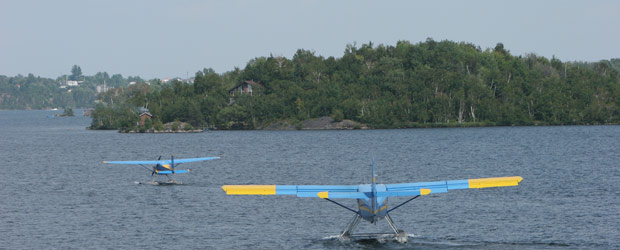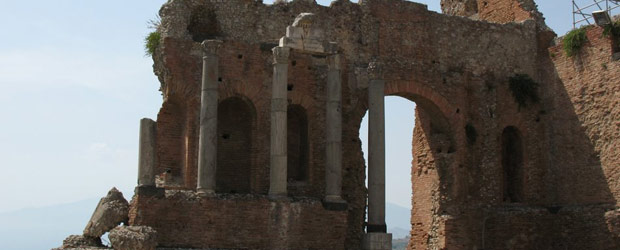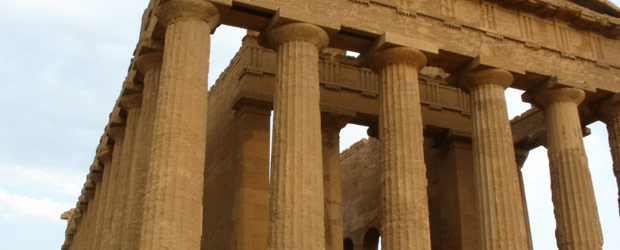Cardona Castle’s history and mystique certainly make it the most amazing medieval fortress in Catalonia.
Sometimes the most romantic, exciting thing you can do is to plan as little as possible while on vacation. We decided, on this tour, until we got a feel for the region or city we were in, we would fly by the seat of our pants as much as possible. A good example of our “going with the flow” would be our stay at Cardona Castle. We saw another castle on the scenic drive to Andorra from Barcelona. It was sitting there in the mist on the side of the road, beckoning us to take that exit. Fortunately, or not, we drove past it, but we knew from that moment that a castle was certainly on our list of things to experience while in the Europe.
Stories
So, upon our return from Andorra we found ourselves making last minute reservations at www.parador.es which has an English version, and got quite the deal for under 30’s that night as well. Now Naia isn’t under 30 anymore… but Dan was still 29, until the end of November and needless to say, we took them up on their offer. So, it was not only one of the most hearty, history-rich fortresses around, it was affordable as well, and with the exchange rate, it was certainly a welcome gift from the powers that be. Winding up the long drive to the top allows you to see 10 miles around or more and, as expected, the sunset was spectacular. The building itself dates from the second century and it was strategically built next to a watch-tower over the Saline Valley. It belonged to the most powerful dynasty ruling between the tenth and seventeenth centuries. The Folch dynasty, heirs of Charlemagne, built this fortress, within the area that was known as “Marca Hispanica” (Border between the Spanish territories and the Muslim ones.) The Folch family ruled all the region and they owned at one point a total of twenty ports. Not too shabby for the good ol’ days, or now!
[scrollGallery id=1]
The fortified, 9th Century fortress, within which the Parador (hotel) is located, conceals a 2nd Century tower and an 11th Century church. Inside the solid stone walls are comfortable, nicely decorated bedrooms, some with four-poster beds. The sparkling clean, marbled bathrooms are spacious, modern and well equipped for the tired traveler. Donned with an ample sized bath/shower as well as hair dryer and other amenities, like quality, yes actual quality shampoo/conditioner/lotion samplers we would actually use, the proprietors pulled out all of the stops. And why not? Frankly, we feel that doing something for the sheer enjoyment and use of the guest is the mark of a sharp hotel owner. The fact that they’re not wasting money on something you won’t use, because it’s not high enough quality, is smart. Also, it proves that they aren’t just for show either. The furniture in the drawing room was inspired from medieval times and helps to set the tone of the hotel. Throughout Cardona the antique furniture and rich decor works quite well with the castle itself. The reception is a beautiful space where there is internet access and cozy couches to regain your strength from a hard day of exploring the area.
When the sun went down, our stomachs woke up and hunger set into full gear, motivating us to take a quick shower to wash off the dust of the day’s explorations before we sought out our dinner. Someone was using the elevator, so we took the steps and couldn’t resist letting our minds wander once again to imagine what it must have been like to live back then… to hear the footsteps of soldiers in the stairwell… the sounds of children playing… Suddenly, we snapped out of our fantasyland when we heard the clinking of silverware and waiters popping corks, instantly causing us to be transported to the present. Upon arriving to the enormous dining area it is easy to imagine a grand ball taking place in the festively decorated dining room. We sat in the back corner and had the pleasure of simply feeling the room full of happy people eating the lovely fare and making merry. The holiday season was upon us and many people there were taking a long weekend break just before the Christmas rush set in at home. The Catalan cuisine is heavily influenced by an assortment of fresh forest mushrooms and a wide variety of homemade sausages and olives, all found locally. The dishes were deliciously prepared and gratefully enjoyed. The “butifarra con mongetes”, (sausage with beans), was lovely, as was the rest of the meal. The service was good and the staff was very friendly and it was quite apparent they were genuinely happy to be there, another trademark of excellent management and care taking of employees. Most staff we encountered at Cardona spoke English at least well enough to have short conversations and give directions and recommendations, which is always a plus as well.
Feeling happily, perfectly satiated, we retired for the evening as Asha was falling asleep in Dan’s arms and it was certainly time for us to examine the insides of our eyelids as well. The mattress and pillows were refreshingly comfortable and morning came too quickly. We were up early and went to the buffet breakfast, which offered a plentiful array of fresh juices, breads, fruits, yogurts, deli meats, sausages, eggs, muffins, croissants, jams, jellies, and more. It was tasty and we ate heartily before we embarked on a “special mission” to get pictures from all over the castle.
Dan’s second, OK… his third big love is History. He got “that look” when he found out that Cardona’s role in the War of Spanish Succession was amongst the most important to be played by any Catalan town. We spent about an hour or so going all over the castle taking pictures from the inside and outside. Out of windows, doors, off the top of balconies, snapping from all directions, trying to capture the feeling of the castle in shade and light. Showcasing her beautiful, if slightly rugged, charisma and class. The strategic and military importance of its fortifications enabled a resistance to be mounted in advance of Bourbon forces on several occasions during the conflict. The scene of this resistance was the town of Cardona itself and the castle.
Yes, before Naia could set up the first shot, Dan was heading up, up, up the stairs to the top of the tower with Asha, a giggling, one year old little explorer, on a quest to figure out which way the intruders must have approached. He continued on, musing about what it must have looked like and how the residents would have taken refuge in the castle and fought alongside the soldiers to defend it. He went on to tell us of three challenges that stood out as being particularly important amongst the events that took place here during the War, such was their magnitude: The siege in November and December 1711, the battles in August and October 1713 and the final capitulation of the castle, on September 18th 1714, a week later than that of Barcelona, when the rest of the country was already under the control of the Bourbon army. Looking out from the castle and it’s archer’s positions, you can just imagine, it must have been an amazing, harrowing time. We were seeing in our minds’ eyes showers of arrows zipping by us, hoping we wouldn’t be the unfortunate targets whose marks were hit.
The story of these three episodes goes something like this… Following the orders issued in Calaf by the French Duke of Vendome, Lt. General the Count of Muret went to Cordona with 25,000 troops. He took the town on November 17th, 1711, but not the castle, which was bombarded with cannon fire for thirty-four days. Imagine being shelled for thirty-four days and you will understand why we were taking all of the pictures. It is a fortress, indeed. During one of the fiercest engagements over the control of the castle, which took place at La Querosa and Els Escorials, Colonel Pere Muntaner-Damon i de Sacosta, who was in command of the castle’s troops, lost his life. Miraculously, despite this potential wrench in their plans, the troops held on for more than a month, until December 18th when the siege was finally lifted, thanks to the arrival of a large allied force commanded by Marshall Guido von Starhemberg and English General James Stanhope.
In August and October 1713, coinciding with the siege of Barcelona (1713 – 1714), Catalan troops under Manuel Desvalls, Military Governor of the castle, resisted two new offenses by the Bourbon forces under the Count of Montemar. Finally, on September 18th 1714, Manuel Desvalls i de Vergos was obliged to surrender the fortress, under the same conditions as those agreed for the capitulation of Barcelona on September 11th 1714.
We would like to return to Cardona Castle in the future to experience some of their seasonal offerings and to hear more of the stories of the many battles and those heroes and heroines of history we so often take for granted. Until next time, via con Dios Cardona!
{tab=Hotel / Accomodation}
Some of the hotel rooms have charming canopy beds. Pits, towers, walls and gothic features come together with a predominantly comfortable décor and Catalan-inspired mediaeval furnishings. Book Now!
- Address: Castell de Cardona, s/n
- Town/City: 08261 Cardona, Barcelona
- Telephone: 00 34 938691275
- Fax: 00 34 938691636
- E-mail: [email protected]
- Constuction style: Castle
- Credit cards: American Express, Diners, JCB, Visa, MasterCard
- Director: Jaime Sebastián Sánchez
- Chef: Manuel Cubilla Moga
GENERAL SERVICES
- Air Conditioning
- Bar
- Bureau de Change
- Conference Suite
- Credit Cards
- Distance to Airport: 100 km.
- Distance to Port: 100 km.
- Distance to Train Station: 32 km.
- Heating
- Life
- No animals allowed
- Restaurant
- Satellite Dish
- Shop
- BEDROOMS
- Canal plus
- Double Rooms (double beds): 5
- Duplex: 2
- Minibar
- Places: 106
- Rooms with Lounge Area: 3
- Safety Deposit Box
- Single Rooms: 2
- Telephone in bedrooms
- Television
- Twin Rooms: 42
- REST AND RELAXATION
Dining & Food
Catalan cuisine is served in the dining room including aubergine terrine with pig’s trotters, selections of sausages and especially barbecue dishes with the braised lamb shoulder a highlight.
Eat like a true king at the Parador’s medieval dining room: Aubergine terrine with pig’s trotters, selections of sausages and specially barbecue dishes with local braised lamb shoulder a highlight Patatas enmascaradas (potatoes served with butifarra sausage and garlic) are a speciality. Hungry?
Activities
- Solsonés Route (15 to 40 km.)
- Romanesque architecture.
- Museums.
- Cardener fountain.
- Cardona town.
- Salt Mountain.
- Cardonal Mediaeval Centre.
- Salt Museum.
- Romanesque architecture.
- Montserrat (45 km.)
- Montserrat Monastery.
- Museum.
- Parador.
- Romanesque church from the 13th century.
- Cloister.
- 2nd century Minyona Tower.
- Walls.
- Bages Route (15 a 45 km.)
- Romanesque architecture.
- Museums.
- Planetarium
- Berguedá Route (30 a 60 km.)
- Pyrenees.
- Romanesque architecture.
- Museums.
- Llobregat fountains.
Local Festivals
- Carnival: February, Solsona, 22 km.
- Cardona annual festival: second Saturday in September, Cardona.
- La Patum: Corpus, Berga, 31 km.





